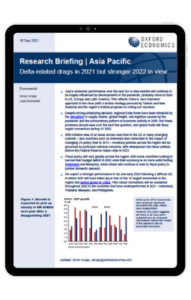APAC: Delta-related drags in 2021 but stronger 2022 in view

Asia’s economic performance over the next six to nine months will continue to be hugely influenced by developments in the pandemic, probably more so than in US, Europe and Latin America. This reflects China’s ‘zero tolerance’ approach to the virus (with a similar strategy pursued by Taiwan and New Zealand) and the region’s limited progress on rolling out vaccines.
What you will learn from this report:
- Despite strong underlying demand, regional trade flows have been hindered by the disruption to supply chains, global freight, and logistics caused by the pandemic and the extraordinary pattern of economic activity in 2020. But these problems should ease over the next few quarters, and global trade will likely regain momentum during H1 2022.
- With inflation less of an issue across Asia than in the US or many emerging markets – and countries such as Indonesia less vulnerable to the impact of changing US policy than in 2013 – monetary policies across the region will be governed by particular national concerns, with widespread rate hikes unlikely before the Federal Reserve raises rates in 2023.
- Fiscal policy will vary greatly across the region, with some countries looking to narrow their budget deficit in 2022 once their economy is on more solid footing (Indonesia and Malaysia), while others will continue to look to fiscal policy to bolster domestic demand.
- We expect a stronger performance in Q4 and early 2022 following a difficult Q3, in which GDP will have fallen q/q in four of the 12 largest economies in the region and barely grown in China. This robust momentum will be sustained throughout 2022 in the countries that have underperformed in 2021 – Indonesia, Thailand, Malaysia, and Philippines.
Tags:
Related Services

Post
House prices continue to slide for China’s cities
Research Briefing APAC: Delta-related drags in 2021 but stronger 2022 in view While the property market downturn has been universal, the scale and depth has been varied for different cities and regions.
Find Out More
Post
The Construction Productivity Challenge in Australia
Delve into the state of construction productivity in Australia. Understand the factors affecting growth and how innovation can transform the industry for the better.
Find Out More